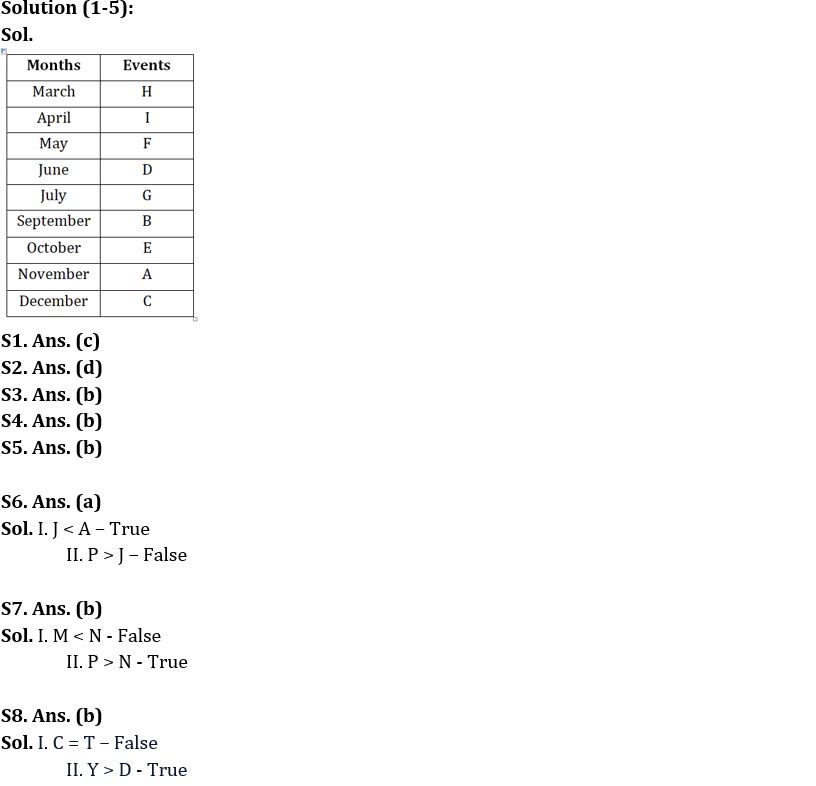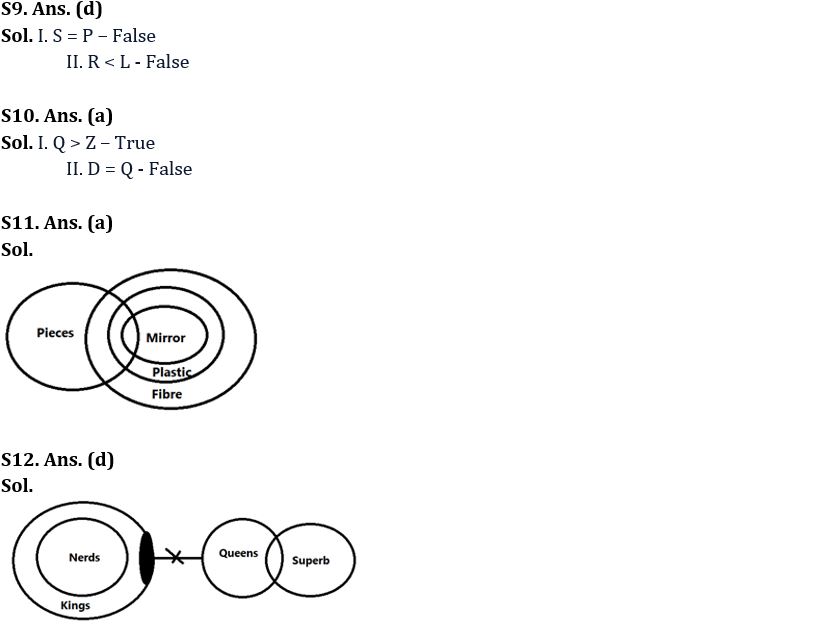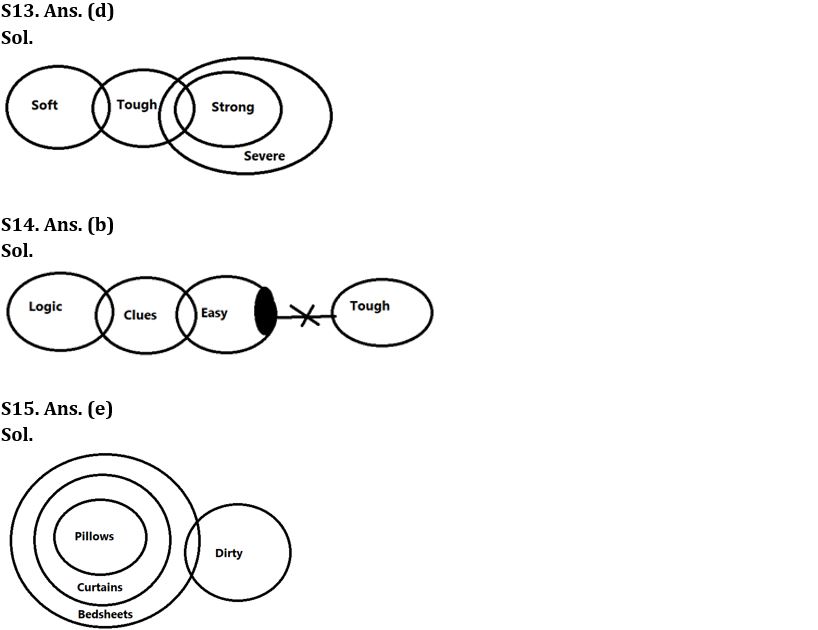Directions (1-5): Answer the questions based on the information given below:
Nine events A, B, C, D, E, F, G, H and I are held on 2nd of different months (March, April, May, June, July, September, October, November and December) in the same year.
E is held three months after G. Three events are held after B. Two events are held between E and D. I is held two months before D. A is not held in any month which has 31 days. F is held after H but not in December.
Q1. Which of the following even is held in November?
(a) D
(b) C
(c) A
(d) F
(e) None of these
Q2. How many events are held before F?
(a) Three
(b) Four
(c) One
(d) Two
(e) None of these
Q3. Which of the following event is held immediately after H?
(a) D
(b) I
(c) A
(d) F
(e) None of these
Q4. How many events are held between A and G?
(a) Three
(b) Two
(c) One
(d) Four
(e) None of these
Q5. Four of the following five are alike in a certain way and hence form a group. Which of the one that doesn’t belong to that group?
(a) D
(b) E
(c) B
(d) A
(e) I
Directions (6-10): In the following questions assuming the given statement to be true, find which of the conclusion(s) among given conclusions is/are definitely true and then give your answers accordingly.
Q6. Statements: P > T > H < J = L ≤ O, O < R < U = M < A=B
Conclusions: I. J < A
II. P > J
(a) Only I is true
(b) Only II is true
(c) Either I or II is true
(d) Neither I nor II is true
(e) Both I and II are true
Q7. Statements: O = T < H< J > M < P, P > U = D > B = N < K
Conclusions: I. M < N
II. P > N
(a) Only I is true
(b) Only II is true
(c) Either I or II is true
(d) Neither I nor II is true
(e) Both I and II are true
Q8. Statements: K = C ≥ D < S = T ≤ Y
Conclusions: I. C = T
II. Y > D
(a) Only I is true
(b) Only II is true
(c) Either I or II is true
(d) Neither I nor II is true
(e) Both I and II are true
Q9. Statements: L = M ≥ P, P < R, L > S
Conclusions: I. S = P
II. R < L
(a) Only I is true
(b) Only II is true
(c) Either I or II is true
(d) Neither I nor II is true
(e) Both I and II are true
Q10. Statements: D < Z < W = N = K ≤ Q
Conclusions: I. Q > Z
II. D = Q
(a) Only I is true
(b) Only II is true
(c) Either I or II is true
(d) Neither I nor II is true
(e) Both I and II are true
Directions (11-15): In the question below, three statements are given followed by the conclusions. You have to take the given statements to be true even if they seem to be at variance with commonly known facts. Read all the conclusions and then decide which of the given conclusions logically follows from the given statements disregarding commonly known facts.
Q11. Statements: Some Pieces are Mirror.
All Mirrors are Plastic.
All Plastic are Fibre.
Conclusions: I. A few Fibre are Pieces
II. All Plastic are Mirrors
(a) Only conclusion I follows
(b) Only conclusion II follows
(c) Either conclusion I or II follows
(d) Both conclusions I and II follow
(e) Neither conclusion I nor II follows
Q12. Statements: All Nerds are Kings.
Some Kings are not Queens.
Some Queens are Superb.
Conclusions: I. Some Superb can be Nerds.
II. Some King are Superb is a possibility.
(a) Only conclusion I follows
(b) Only conclusion II follows
(c) Either conclusion I or II follows
(d) Both conclusions I and II follow
(e) Neither conclusion I nor II follows
Q13. Statements: Some Soft are Tough.
Some Tough are Strong.
All Strong are Severe.
Conclusions: I. Some Severe can be Soft
II. Some Strong are Tough
(a) Only conclusion I follows
(b) Only conclusion II follows
(c) Either conclusion I or II follows
(d) Both conclusions I and II follow
(e) Neither conclusion I nor II follows
Q14. Statements: Some Logic are Clues.
Some Clues are Easy.
Some Easy are not Tough.
Conclusions: I. Some Easy are not Clues.
II. Some Tough can be Logic.
(a) Only conclusion I follows
(b) Only conclusion II follows
(c) Either conclusion I or II follows
(d) Both conclusions I and II follow
(e) Neither conclusion I nor II follows
Q15. Statements: All Pillows are Curtains.
All Curtains are Bedsheets.
Some Bedsheets are Dirty.
Conclusions: I. Some Dirty are Pillows
II. All Bedsheets are Pillows
(a) Only conclusion I follows
(b) Only conclusion II follows
(c) Either conclusion I or II follows
(d) Both conclusions I and II follow
(e) Neither conclusion I nor II follows
Solutions








 Profit, Loss & Discount – Concept + ...
Profit, Loss & Discount – Concept + ...
 Nainital Bank Recruitment 2025-26 Notifi...
Nainital Bank Recruitment 2025-26 Notifi...
 Daily Current Affairs Quiz 13 December 2...
Daily Current Affairs Quiz 13 December 2...








